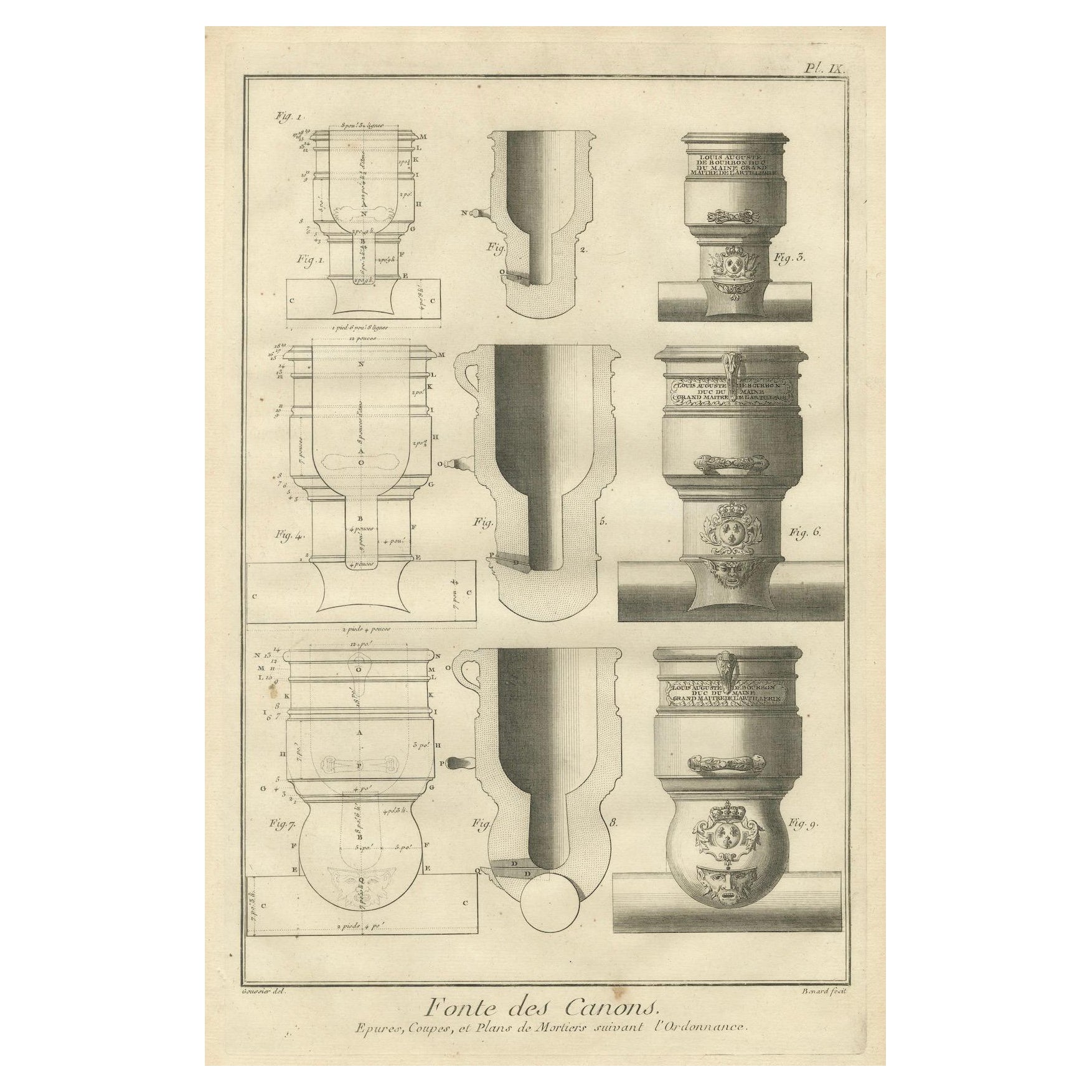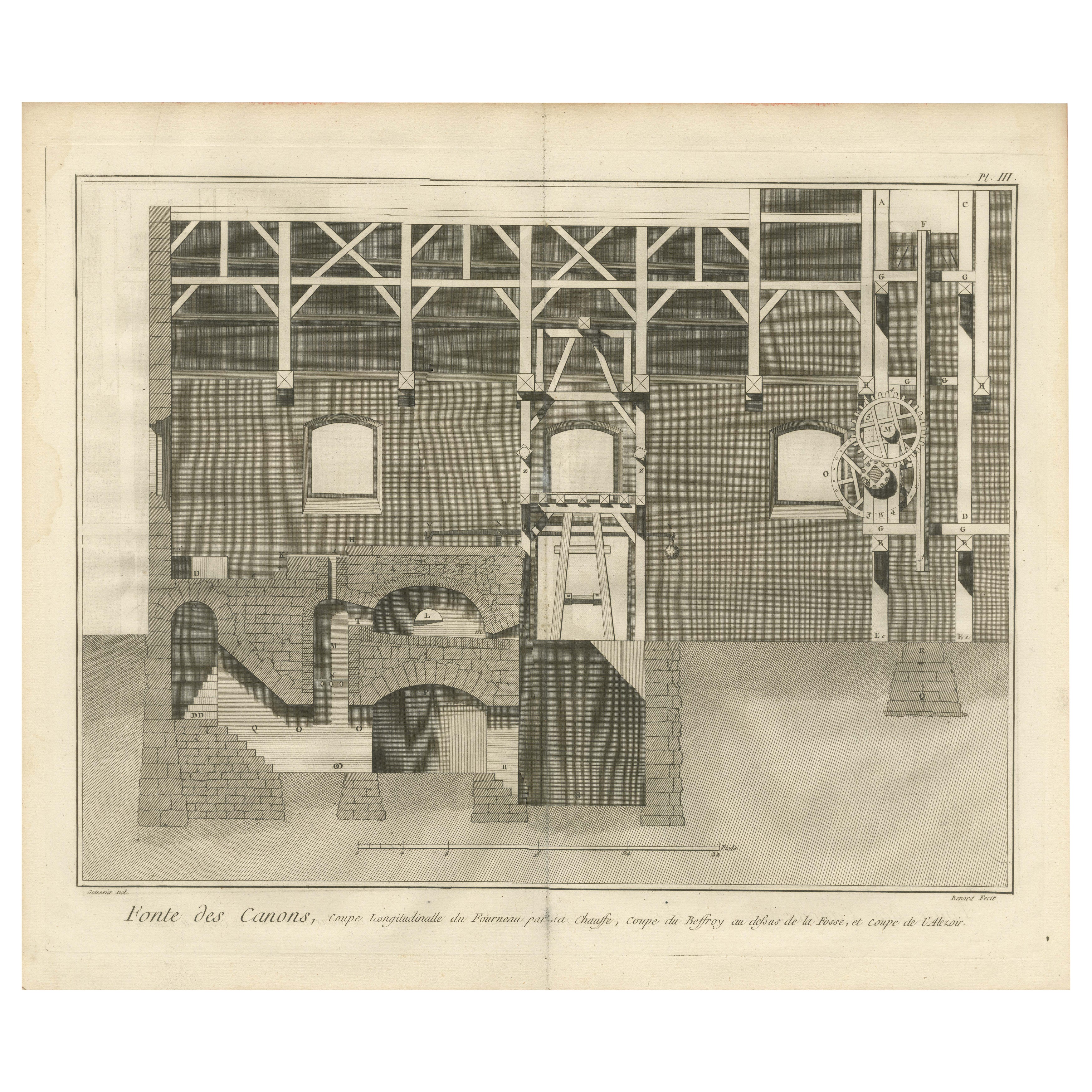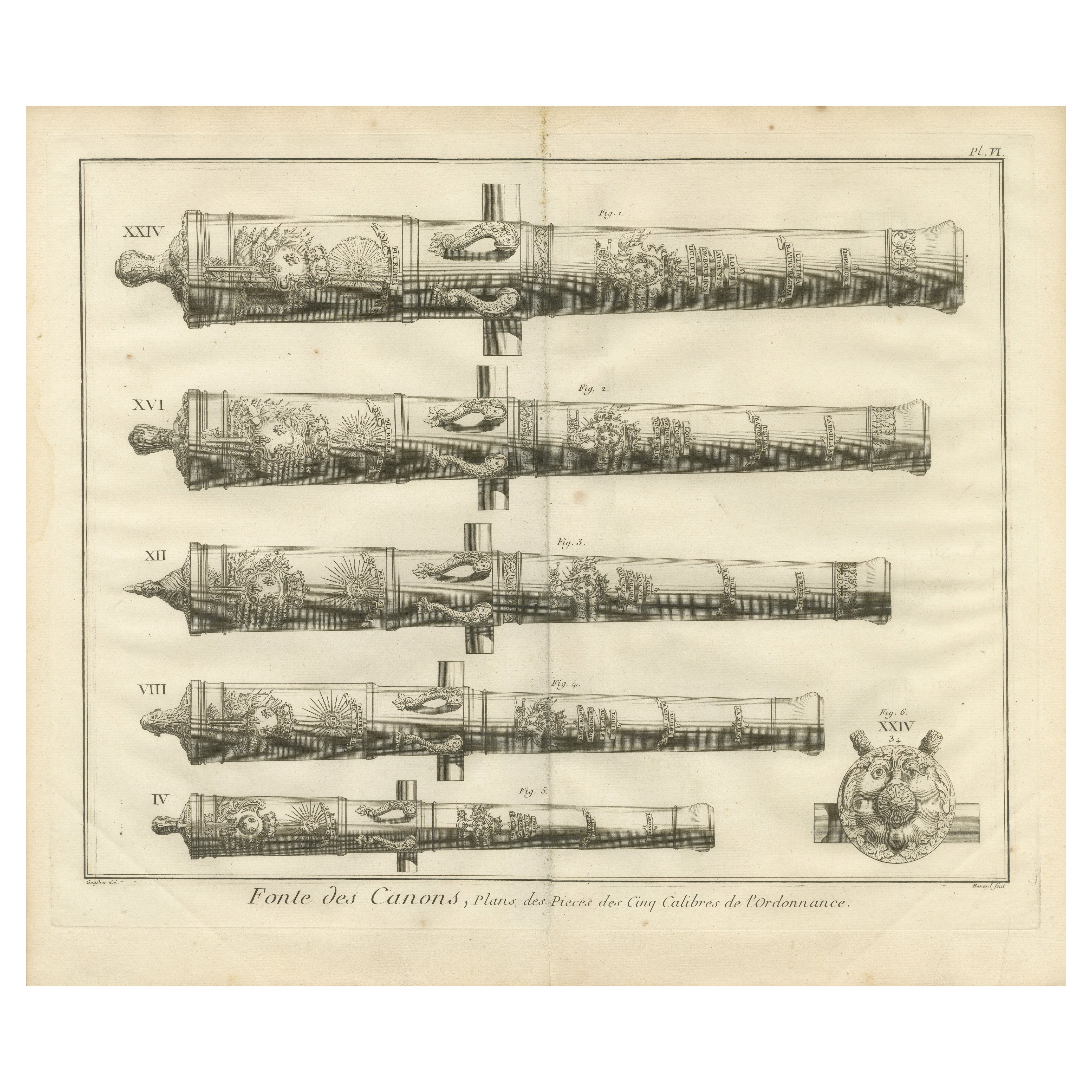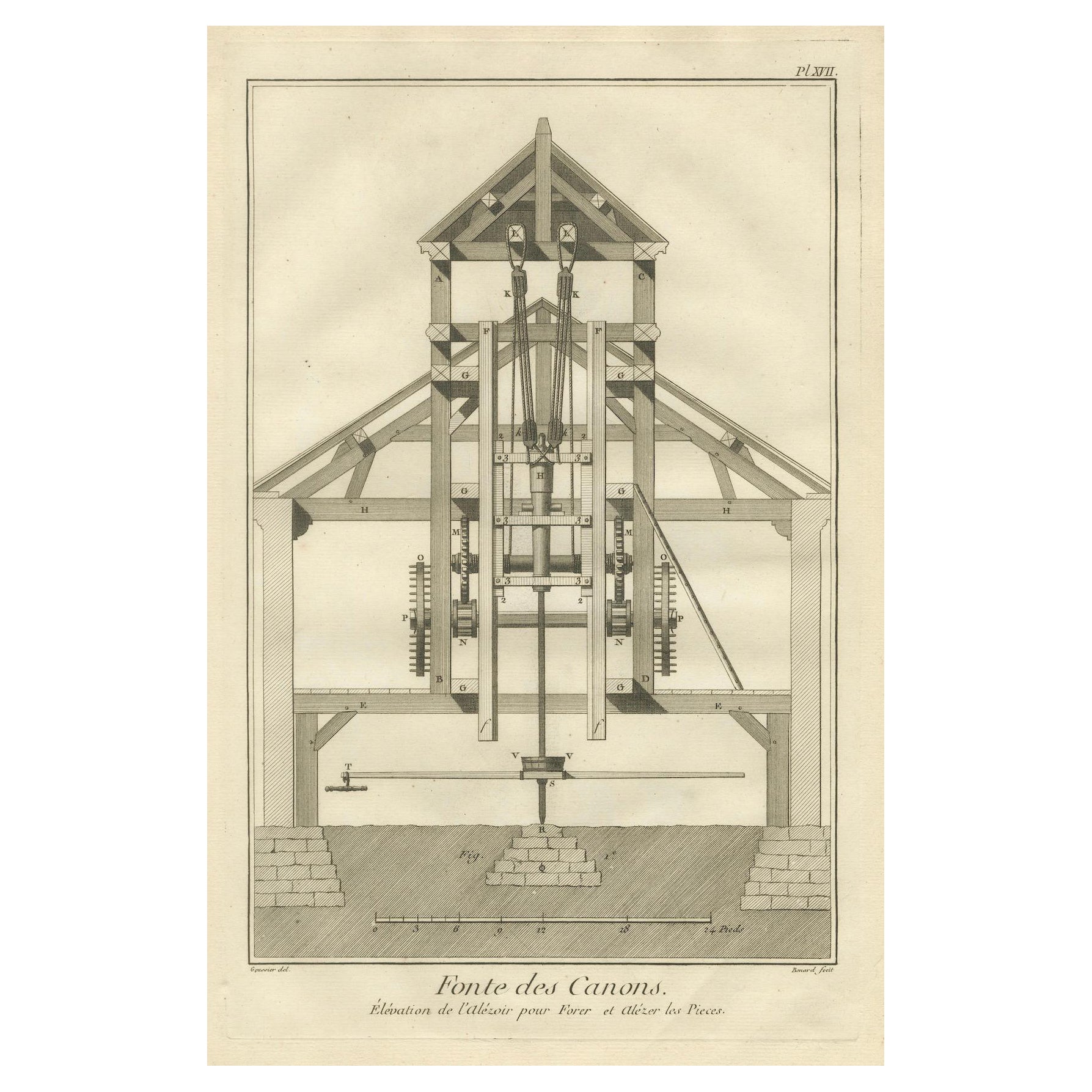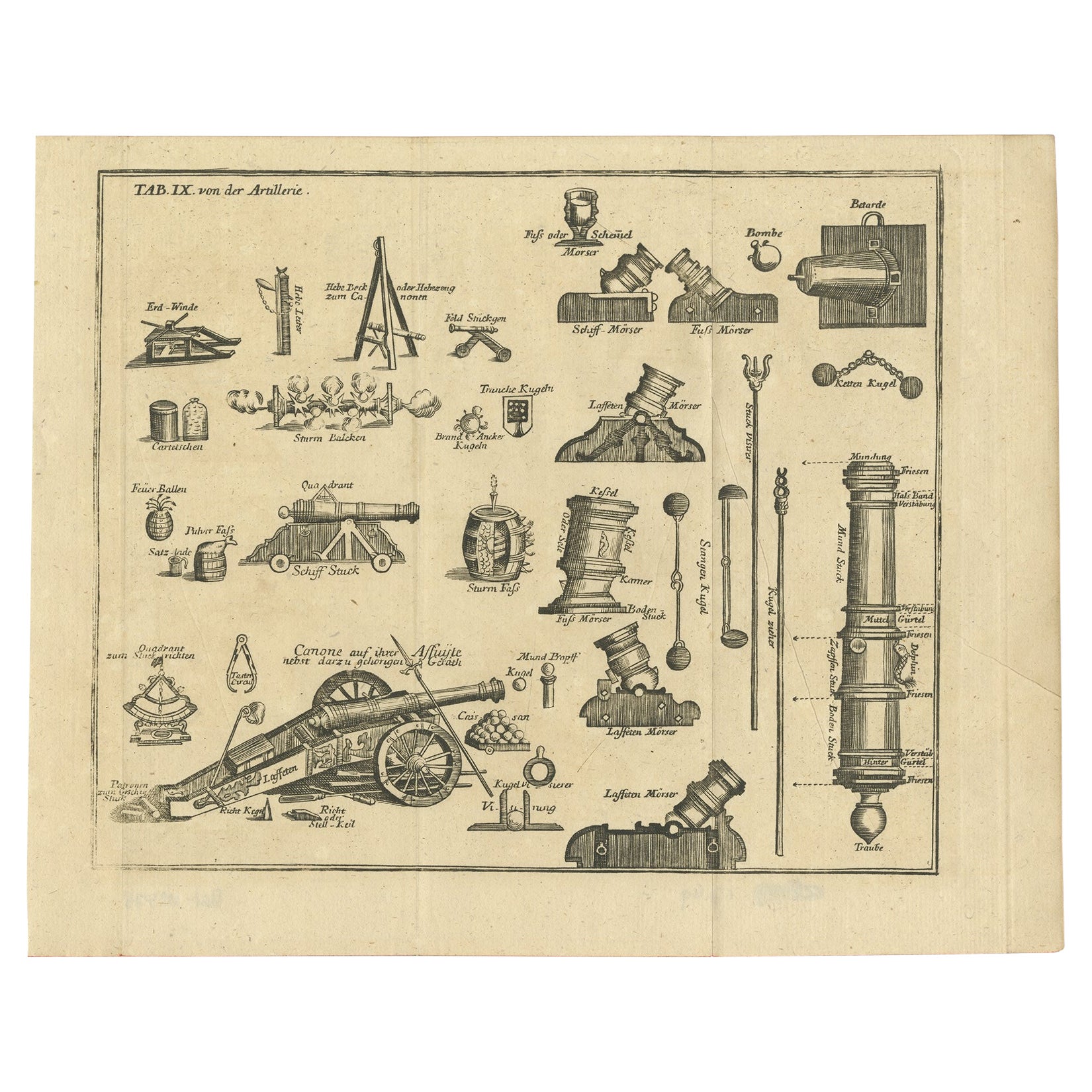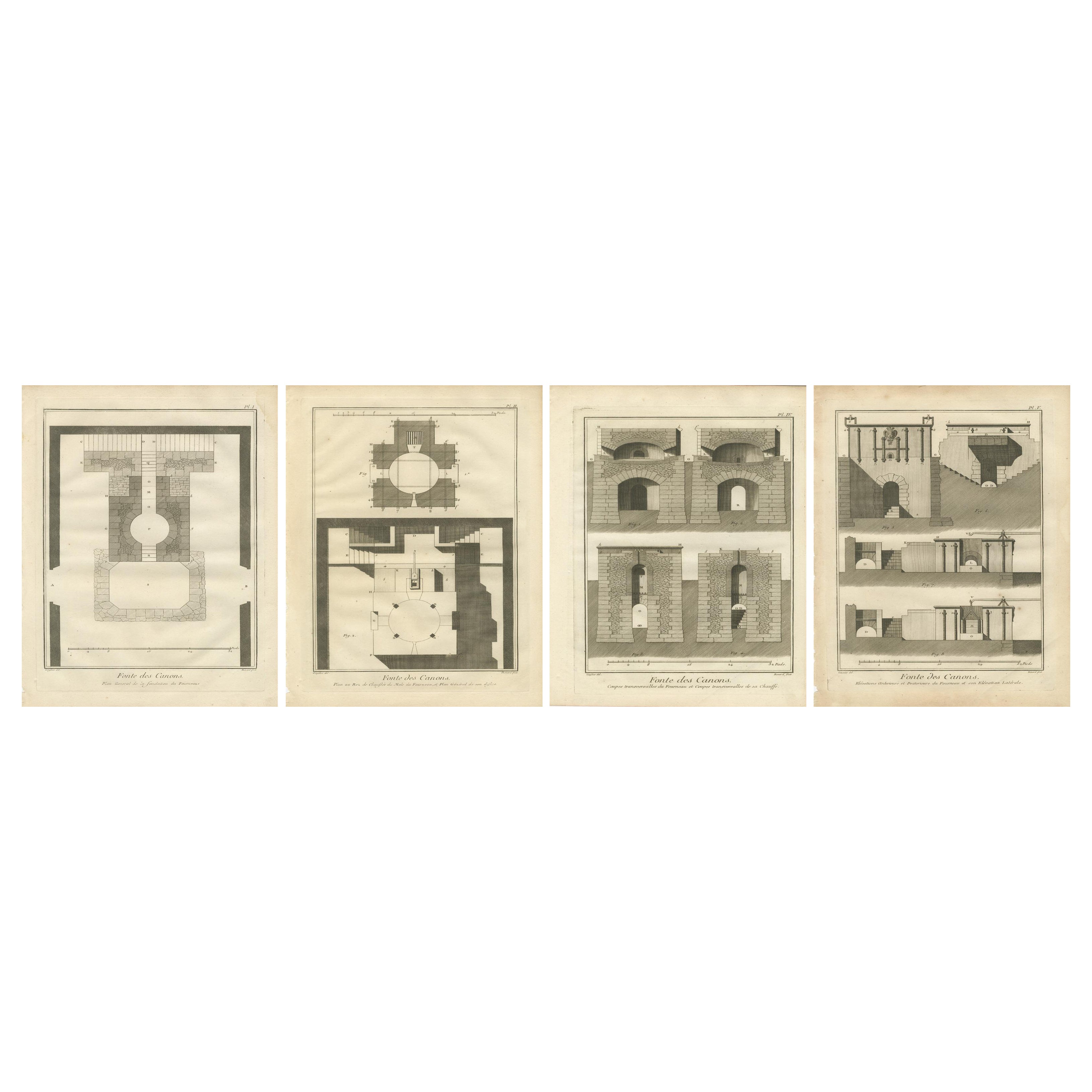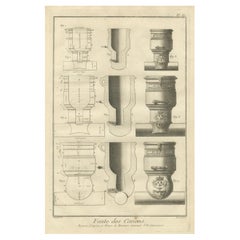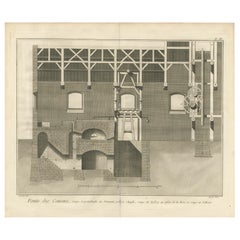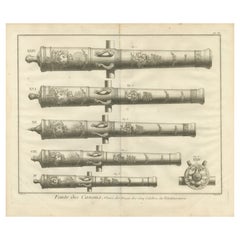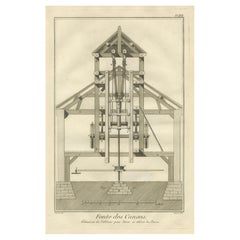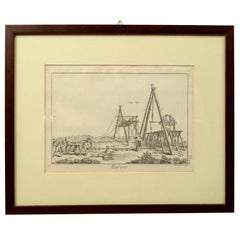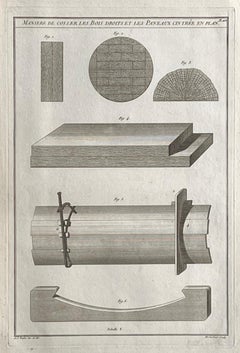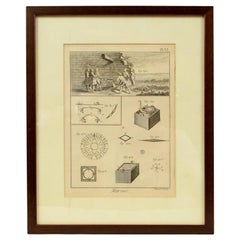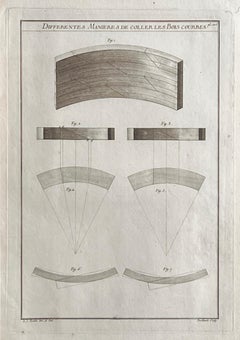Items Similar to 18th-Century Engraving of Mortar and Howitzer Design from Diderot's Encyclopédie
Want more images or videos?
Request additional images or videos from the seller
1 of 10
18th-Century Engraving of Mortar and Howitzer Design from Diderot's Encyclopédie
$391.39
£293.80
€330
CA$547.55
A$599.29
CHF 311.51
MX$7,212.63
NOK 3,916.20
SEK 3,673.52
DKK 2,514.18
About the Item
Title: 18th-Century Engraving of Mortar and Howitzer Design from Diderot's Encyclopédie
Description: This original 18th-century engraving is a highly detailed technical illustration of mortar and howitzer designs, produced for the monumental Encyclopédie, ou Dictionnaire raisonné des sciences, des arts et des métiers by Denis Diderot and Jean-Baptiste Le Rond d'Alembert. The Encyclopédie was one of the most ambitious publishing projects of the Enlightenment, aimed at documenting and disseminating knowledge across a vast range of scientific and artistic disciplines, including military engineering and artillery manufacturing.
The engraving meticulously depicts various mortars and howitzers, presenting precise cross-sections, dimensional schematics, and external decorations. The upper section of the plate features different mortar designs, including a side elevation and sectional cut revealing the interior structure, bore diameter, and reinforcement thickness. These elements were crucial for understanding the effectiveness of mortars in siege warfare, as these weapons were designed to lob explosive shells at high trajectories over fortifications. The lower section showcases additional mortars with detailed measurements, annotations, and ornamental embellishments, such as elaborate royal insignias and decorative cartouches, which indicate the prestigious craftsmanship involved in casting artillery pieces for European monarchies.
The attention to detail in this engraving highlights the scientific precision of 18th-century foundry techniques. The dimensions, weight distribution, and internal mechanics of the artillery pieces are clearly outlined, demonstrating the advancements in metallurgy and ballistics of the time. Mortars and howitzers were essential in military campaigns, particularly for breaking fortifications and creating breaches in defensive walls. The inclusion of decorative elements, such as coats of arms and inscriptions, suggests that some of these pieces were specially commissioned for royal or high-ranking military use.
The engraving also serves as a historical document showcasing the intersection of science, technology, and warfare. During the 18th century, European nations invested heavily in the development of artillery, and technical manuals like the *Encyclopédie* played a key role in standardizing knowledge and improving production methods. The precise mathematical and geometrical calculations inscribed on the plate illustrate the growing influence of scientific principles in military engineering.
Condition Report:
This engraving is in very good condition, with only minor signs of age-related wear. The paper is well-preserved, with light toning and some faint foxing near the edges, consistent with its age. The impression remains strong and well-defined, with fine lines and shading techniques clearly visible. The margins are intact, allowing for easy framing. There are no tears, major stains, or significant creases affecting the image.
Framing Tips:
To enhance the presentation and longevity of this engraving, it is recommended to use acid-free matting and UV-resistant glass to prevent light damage. A classic black or dark wood frame will complement the engraving's historical and technical nature, drawing attention to its intricate details. Mounting it alongside other engravings from the *Encyclopédie* would create an impressive display of Enlightenment-era scientific and artistic knowledge. This engraving is an excellent addition to any collection focused on military history, engineering, or 18th-century technology.
- Dimensions:Height: 15.67 in (39.8 cm)Width: 10.24 in (26 cm)Depth: 0.01 in (0.2 mm)
- Materials and Techniques:Paper,Engraved
- Period:1770-1779
- Date of Manufacture:circa 1770
- Condition:This engraving is in very good condition, with only minor signs of age-related wear. The paper is well-preserved, with light toning and some faint foxing near the edges, consistent with its age. The impression remains strong and well-defined.
- Seller Location:Langweer, NL
- Reference Number:Seller: BG-13998-101stDibs: LU3054343935842
About the Seller
5.0
Recognized Seller
These prestigious sellers are industry leaders and represent the highest echelon for item quality and design.
Platinum Seller
Premium sellers with a 4.7+ rating and 24-hour response times
Established in 2009
1stDibs seller since 2017
2,689 sales on 1stDibs
Typical response time: <1 hour
- ShippingRetrieving quote...Shipping from: Langweer, Netherlands
- Return Policy
Authenticity Guarantee
In the unlikely event there’s an issue with an item’s authenticity, contact us within 1 year for a full refund. DetailsMoney-Back Guarantee
If your item is not as described, is damaged in transit, or does not arrive, contact us within 7 days for a full refund. Details24-Hour Cancellation
You have a 24-hour grace period in which to reconsider your purchase, with no questions asked.Vetted Professional Sellers
Our world-class sellers must adhere to strict standards for service and quality, maintaining the integrity of our listings.Price-Match Guarantee
If you find that a seller listed the same item for a lower price elsewhere, we’ll match it.Trusted Global Delivery
Our best-in-class carrier network provides specialized shipping options worldwide, including custom delivery.More From This Seller
View AllRoyal Artillery of the Enlightenment: 1770's Engraving of Mortars and Howitzers
Located in Langweer, NL
Royal Artillery of the Enlightenment: 18th-Century Engraving of Mortars and Howitzers
Description: This extraordinary 18th-century engraving offers a detailed and visually strikin...
Category
Antique 1770s Prints
Materials
Paper
18th Century Cannon Foundry Engraving from Diderot’s Encyclopédie, circa 1770
Located in Langweer, NL
18th Century Cannon Foundry Engraving from Diderot’s Encyclopédie, circa 1770
This fine 18th-century engraving, titled Fonte des Canons, origin...
Category
Antique 1770s Prints
Materials
Paper
18th Century Engraving of Ornate French Cannons, circa 1770
Located in Langweer, NL
18th Century Engraving of Ornate French Cannons from Diderot’s Encyclopédie, circa 1770
This exceptional 18th-century engraving, titled Fonte des Cano...
Category
Antique 1770s Prints
Materials
Paper
Eighteenth-Century Engraving of a Cannon-Boring Machine from Fonte des Canons
Located in Langweer, NL
Eighteenth-Century Engraving of a Cannon-Boring Machine from Fonte des Canons
Description: This highly detailed eighteenth-century engraving illustrates a cannon-boring machine used...
Category
Antique 1770s Prints
Materials
Paper
$313 Sale Price
20% Off
Antique Engravring of Different Artillery like Bullets, Cannons, Bombs, c.1769
Located in Langweer, NL
Antique print titled ‚Tab IX. von der Artillerie‘.
This print depicts many different artillery like bullets, cannons, bombs and many more. German subtitles.
Artists and Engra...
Category
Antique 1760s Prints
Materials
Paper
$218 Sale Price
20% Off
Set of 1770s Cannon Foundry Engravings from Diderot’s Encyclopédie, France
Located in Langweer, NL
Title: Set of 1770s Cannon Foundry Engravings from Diderot’s Encyclopédie, France
Description: This set of eighteenth-century engravings, titled Fonte des Canons, originates from ...
Category
Antique 1770s Prints
Materials
Paper
$275 Sale Price / set
20% Off
You May Also Like
Engraving Print from the Panckoucke Encyclopédie Nautical Subject 1782-1832
Located in Milan, IT
Print by engraving on copper plate from the Panckoucke Encyclopédie méthodique, end of the 18th century,volume Marine Planches (more than 1,500 figures dealing with all subjects on the marina: planes, construction, carpentry, tree trunks, armaments of maneuvers, ropes, sails, artillery, ship maneuvers and combat tactics). This is the plate no. n. 24, pag. 69 fig. 341 ; with frame cm 38.3 x 31.5. Ship ropes are depicted. The Print has the "Benard direxit...
Category
Antique 1790s French Nautical Objects
Materials
Paper
Maniere de Coller Les Bois Droits, Roubo French cabinetmaking design engraving
Located in Melbourne, Victoria
'Maniere de Coller Les Bois Droit et Les Paneaux Cintree en Plan'
French copper-line engraving by Michelinot after Andre Jacob Roubo (1739–1791). 18th century laid watermarked paper...
Category
Late 18th Century French School Interior Prints
Materials
Engraving
Engraving Print from the Panckoucke Encyclopédie Nautical Subject 1782-1832
Located in Milan, IT
Print by engraving on copper plate from the Panckoucke Encyclopédie méthodique, end of the 18th century, volume Marine Planches (more than 1,500 figures dealing with all subjects on ...
Category
Antique 1790s French Nautical Objects
Materials
Paper
Differents Manieres de Coller, Roubo French cabinetmaking design engraving
Located in Melbourne, Victoria
'Differents Manieres de Coller les Bois Courbes'
French copper-line engraving by Berthault after Andre Jacob Roubo (1739–1791). 18th century laid watermarked paper.
From Roubo's 'L...
Category
Late 18th Century French School Interior Prints
Materials
Engraving
Maniere de Disposer La Menuiserie, Roubo French cabinetmaking design engraving
Located in Melbourne, Victoria
'Maniere de Disposer La Menuiserie pour Recevoir La Sculpture'
French copper-line engraving by Berthault after Andre Jacob Roubo (1739–1791). 18th century laid watermarked paper.
F...
Category
Late 18th Century French School Interior Prints
Materials
Engraving
Maniere De Construire Les Bazes, Roubo French cabinetmaking design engraving
Located in Melbourne, Victoria
'Maniere de Construire Les Bazes, Les Chapiteaux et Les Entablements en Bois'
French copper-line engraving by Berthault after Andre Jacob Roubo (1739–1791). 18th century laid waterm...
Category
Late 18th Century French School Interior Prints
Materials
Engraving
More Ways To Browse
Royal Insignia
Porcelain Monkeys
Porcelain Panther
Postal Scale
Pottery Bank
Pre Columbian Peru Chimu
Punch And Judy
Quito School
Ray Kaiser
Red Robin Vintage
Repurposed Industrial
Reticulated China
Retro Drawers
Revolving Book Table
Roman Chest
Rosenthal Studio Linie Bjorn Wiinblad
Round Marble Column
Royal Doulton Arts And Crafts
